<strong>Open</strong> <strong>Planning</strong> <strong>of</strong> <strong>Sanitation</strong> <strong>Systems</strong>Appendix 1: A Definition and Identification <strong>of</strong> Criteria for theSustainability <strong>of</strong> <strong>Sanitation</strong> <strong>Systems</strong> – 3rd DraftTo be published within the EcoSanRes 1 programmePatrick Bracken (GTZ), Anders Finnson (Stockholm Water Company), Elisabeth Kvarnström *(EcoSanRes), Erik Kärrman (Urban Water), Darren Saywell (WSSCC) and Alberto Ysunza(CECIPROC).* Contact person, address: VERNA Ecology, Inc; Malmgårdsvägen 14, 116 38 Stockholm, Sweden, e-mail: elisabeth@verna.se, phone #: +46-70-6178855BACKGROUNDThis working paper is the result <strong>of</strong> a three-day meeting held in Stockholm where sustainability inrelation to sanitation was discussed and an extensive list <strong>of</strong> criteria to meet sustainability in sanitationwas proposed. The organizations present at the meeting were• EcoSanRes, a Sida-funded environmental and development programme on ecological sanitation• Deutsche Gesellschaft für Technische Zusammenarbeit, GTZ• Centro de Capacitación Integral para Promotores Communitarios, CECIPROC in Mexico• Urban Water, a Swedish research programme on Sustainable Urban Water Management• Stockholm Water CompanyWater Supply and <strong>Sanitation</strong> Collaborative Council participated through written comments.SYSTEM BOUNDARY DEFINITIONAn additional, important consideration during the meeting was to identify what would be the appropriateboundaries <strong>of</strong> a sanitation system. This is <strong>of</strong> utmost importance when comparing different systems for aparticular context, and should be determined in such a way as to ensure that there is no export in eitherspace or time <strong>of</strong> problems that may be created by the system. It is reasonable to include at least the user<strong>of</strong> the system, the management <strong>of</strong> wastewater and its residual fractions, within the system boundaries.It is also possible, and even desirable, to include generation <strong>of</strong> nutrients and recovery <strong>of</strong> energy withinthe system boundaries.SUGGESTION OF CRITERIA TO CONSIDER FOR SANITATION SYSTEMS TO BESUSTAINABLEIt is impossible to identify a complete list <strong>of</strong> factors that will affect the sustainability <strong>of</strong> a sanitationsystem without knowing the specific context. Moreover, a list <strong>of</strong> criteria will not provide easy answers inthe decision-making process but it will help narrow down the discussion. The attempt here is therefore totry and present an extensive range <strong>of</strong> different criteria that might be <strong>of</strong> importance in different contexts.The list would need to be reduced/expanded for each specific case. There will also be a need to identifylocally relevant criteria that do not appear on this suggested list, irrespective <strong>of</strong> level <strong>of</strong> intervention,in close cooperation with all relevant stakeholders, the current legal framework and current cultural1 EcoSanRes (ecological sanitation research) is an international environment and development programme on ecologicalsanitation. It has its roots in the pioneering SanRes programme which ran from 1993 to 2002. It is sponsored by Sida,managed by Stockholm Environment Institute with Akkadia Environment, SwedEnviro and Vatema, and brings together aworld network <strong>of</strong> 20 organisations. For more information on the EcoSanRes programme, please consult www.ecosanres.org15
Elisabeth Kvarnström and Ebba af Petersenspractices. The content <strong>of</strong> the list may depend on the level at which the criteria are used (household,neighbourhood, community, municipality, government, international donors etc.). Moreover, the listproposed here does not take into account the fact that certain criteria might need to be considered atdifferent stages in the planning process and that there might be a need to weigh criteria against eachother. For the specific planning case there is also a need to connect this criteria list to a sanitationplanning tool adapted for the level <strong>of</strong> intervention. A list <strong>of</strong> criteria could also serve as a checklist toidentify knowledge gaps for different sanitation systems, with respect to their sustainability in a givensetting.Below we present what we think might be important criteria, with which one could assess differentsanitation systems before deciding what approach/system/technique would be the most suitable in agiven setting. This list <strong>of</strong> criteria is based on the work <strong>of</strong> several different authors who have workedin this area (e.g. Balkema, 2003; Hellström et al., 2000; Urban Water, 2004; Larsen & Gujer, 1997;Larsen & Lienert, 2003; Lennartsson, 2004) as well as on the discussions held during the meeting. Theyhave been divided into five broad categories <strong>of</strong> criteria which we believe cover the main areas to beaddressed by a sanitation system. The list will hopefully encourage discussion and we would welcomeall feedback related to it.CriteriaIndicatorHealthRisk <strong>of</strong> infection <strong>of</strong> complete use <strong>of</strong> systemRisk <strong>of</strong> exposure to harmful substances: heavy metals, medical residues,organic compoundsRisk assessment or qualitativeRisk assessment or qualitativeEnvironment• Use <strong>of</strong> natural resources, construction:• Land (investment)• Energy• Construction materials• Chemicalsm 2 /peMJ/peType and volumeType and volumeUse <strong>of</strong> natural resources, O&M:• Land (investment)• Energy• Fresh water• Construction materials• Precipitation agents or other chemicalsm 2 /pe/yrMJ/pe/yrm 3 /pe/yrType and volume/pe/yrType and volume/pe/yrDischarge to water bodies:• BOD/COD• Impact on eutrophication• Hazardous substances: heavy metals, persistent organic compounds,antibiotics/medical residues, hormonesg/pe/yrg/pe/yr <strong>of</strong> NPmg/pe/yrAir emissions:• Contribution to global warming• Odourkg <strong>of</strong> CO 2equivalent/yrQualitativeResources recovered (potential for approaches):• Nutrients% <strong>of</strong> incoming to system <strong>of</strong> NPKS16


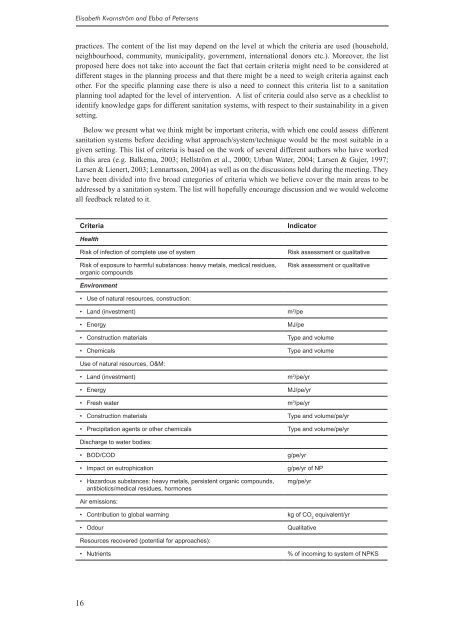
![Project Document [PDF: 2.31 MB] - EcoSanRes](https://img.yumpu.com/51279385/1/184x260/project-document-pdf-231-mb-ecosanres.jpg?quality=85)


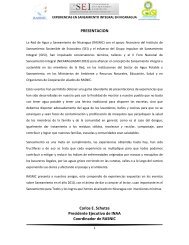
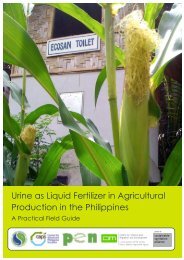

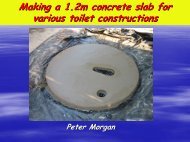
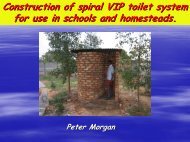


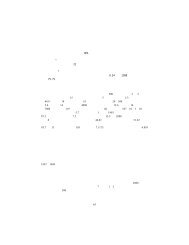
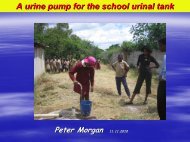
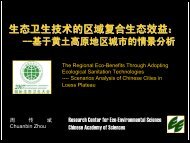
![Latrines à compost [high-resolution colour PDF: 12.3MB] - EcoSanRes](https://img.yumpu.com/31726141/1/185x260/latrines-a-compost-high-resolution-colour-pdf-123mb-ecosanres.jpg?quality=85)